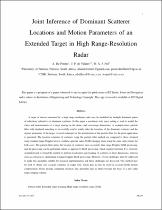 ResearchSpace
ResearchSpace
Joint inference of dominant scatterer locations and motion parameters of an extended target in high range-resolution radar
JavaScript is disabled for your browser. Some features of this site may not work without it.
- ResearchSpace
- →
- Research Publications/Outputs
- →
- Journal Articles
- →
- View Item
| dc.contributor.author |
De Freitas, A

|
|
| dc.contributor.author |
De Villiers, Johan P

|
|
| dc.contributor.author |
Nel, Willem AJ

|
|
| dc.date.accessioned | 2017-07-28T09:37:34Z | |
| dc.date.available | 2017-07-28T09:37:34Z | |
| dc.date.issued | 2015-06 | |
| dc.identifier.citation | De Freitas, A., De Villiers, J.P. and Nel,W.A.J. 2015.Joint inference of dominant scatterer locations and motion parameters of an extended target in high range-resolution radar. IET Radar Sonar and Navigation, 9(5), pp 519–530 | en_US |
| dc.identifier.issn | 1751-8784 | |
| dc.identifier.uri | http://ieeexplore.ieee.org/xpls/abs_all.jsp?arnumber=7095726 | |
| dc.identifier.uri | http://hdl.handle.net/10204/9414 | |
| dc.description | Copyright: 2015 Institution of Engineering and Technology (IET). This is a post-print version. The definitive version of the work is published in IET Radar Sonar and Navigation, 9(5), pp 519–530 | en_US |
| dc.description.abstract | A target of interest measured by a high range resolution radar may be modelled by multiple dominant points of reflections referred to as dominant scatterers. In this study a non-linear state space setting is used to model the states and measurements of a target moving in two dimensions. A resample-move particle filter (PF) with simulated annealing is successfully used to jointly infer the locations of the dominant scatterers and the motion parameters of the target. The location estimates of scatterers using the PF method are compared with those obtained using standard range-Doppler inverse synthetic aperture radar (ISAR) imaging when using the same radar returns for both cases. The PF infers the location of scatterers more accurately than ISAR processing, and the processing can be performed online as opposed to ISAR processing, which requires batching. It is relatively straightforward to extend the method to perform localisation and tracking of scatterers in three dimensions, whereas such an extension is challenging in ISAR processing. However, several challenges need be addressed to make this algorithm suitable for practical implementation and these challenges are discussed. This method may be used to obtain very accurate estimates of target state, which may in turn be used for accurate ISAR motion compensation.Given enough computing resources this algorithm may in future become the basis of a new radar target imaging scheme. | en_US |
| dc.language.iso | en | en_US |
| dc.publisher | Institution of Engineering and Technology (IET) | en_US |
| dc.relation.ispartofseries | Workflow;16109 | |
| dc.subject | Particle filter | en_US |
| dc.subject | Extended target tracking | en_US |
| dc.subject | High range-resolution radar | en_US |
| dc.subject | Inverse synthetic aperture radar | en_US |
| dc.subject | ISAR | en_US |
| dc.title | Joint inference of dominant scatterer locations and motion parameters of an extended target in high range-resolution radar | en_US |
| dc.type | Article | en_US |
| dc.identifier.apacitation | De Freitas, A., De Villiers, J. P., & Nel, W. A. (2015). Joint inference of dominant scatterer locations and motion parameters of an extended target in high range-resolution radar. http://hdl.handle.net/10204/9414 | en_ZA |
| dc.identifier.chicagocitation | De Freitas, A, Johan P De Villiers, and Willie AJ Nel "Joint inference of dominant scatterer locations and motion parameters of an extended target in high range-resolution radar." (2015) http://hdl.handle.net/10204/9414 | en_ZA |
| dc.identifier.vancouvercitation | De Freitas A, De Villiers JP, Nel WA. Joint inference of dominant scatterer locations and motion parameters of an extended target in high range-resolution radar. 2015; http://hdl.handle.net/10204/9414. | en_ZA |
| dc.identifier.ris | TY - Article AU - De Freitas, A AU - De Villiers, Johan P AU - Nel, Willie AJ AB - A target of interest measured by a high range resolution radar may be modelled by multiple dominant points of reflections referred to as dominant scatterers. In this study a non-linear state space setting is used to model the states and measurements of a target moving in two dimensions. A resample-move particle filter (PF) with simulated annealing is successfully used to jointly infer the locations of the dominant scatterers and the motion parameters of the target. The location estimates of scatterers using the PF method are compared with those obtained using standard range-Doppler inverse synthetic aperture radar (ISAR) imaging when using the same radar returns for both cases. The PF infers the location of scatterers more accurately than ISAR processing, and the processing can be performed online as opposed to ISAR processing, which requires batching. It is relatively straightforward to extend the method to perform localisation and tracking of scatterers in three dimensions, whereas such an extension is challenging in ISAR processing. However, several challenges need be addressed to make this algorithm suitable for practical implementation and these challenges are discussed. This method may be used to obtain very accurate estimates of target state, which may in turn be used for accurate ISAR motion compensation.Given enough computing resources this algorithm may in future become the basis of a new radar target imaging scheme. DA - 2015-06 DB - ResearchSpace DP - CSIR KW - Particle filter KW - Extended target tracking KW - High range-resolution radar KW - Inverse synthetic aperture radar KW - ISAR LK - https://researchspace.csir.co.za PY - 2015 SM - 1751-8784 T1 - Joint inference of dominant scatterer locations and motion parameters of an extended target in high range-resolution radar TI - Joint inference of dominant scatterer locations and motion parameters of an extended target in high range-resolution radar UR - http://hdl.handle.net/10204/9414 ER - | en_ZA |





